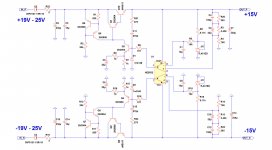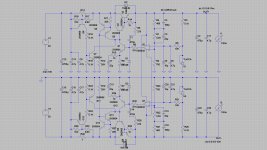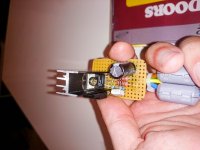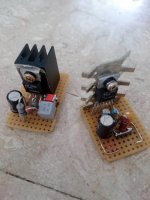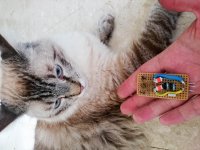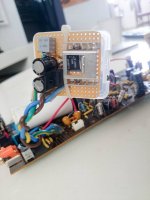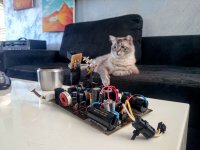Response to a current saltus.
Loading-100ma current, is set by the constant resistor of 150 Ohms on an output. Current races about 100 mA. Frequency-1kHz.
.
Loading-100ma current, is set by the constant resistor of 150 Ohms on an output. Current races about 100 mA. Frequency-1kHz.
.
Attachments
-
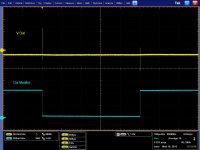 begemot_101_Vout_100us.jpg78.2 KB · Views: 631
begemot_101_Vout_100us.jpg78.2 KB · Views: 631 -
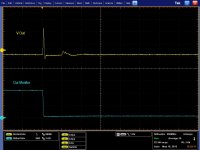 begemot_102_Vout_500ns_dnstep.jpg78.5 KB · Views: 610
begemot_102_Vout_500ns_dnstep.jpg78.5 KB · Views: 610 -
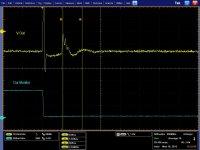 begemot_103_Vout_500ns_dnstep_10mv.jpg84.8 KB · Views: 611
begemot_103_Vout_500ns_dnstep_10mv.jpg84.8 KB · Views: 611 -
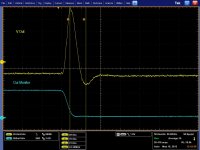 begemot_104_Vout_50ns_dnstep_20mv.jpg85.5 KB · Views: 601
begemot_104_Vout_50ns_dnstep_20mv.jpg85.5 KB · Views: 601 -
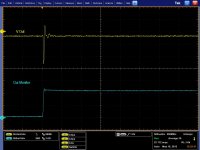 begemot_105_Vout_500ns_upstep.jpg80.3 KB · Views: 594
begemot_105_Vout_500ns_upstep.jpg80.3 KB · Views: 594 -
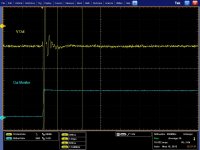 begemot_106_Vout_500ns_upstep_10mv.jpg87.7 KB · Views: 100
begemot_106_Vout_500ns_upstep_10mv.jpg87.7 KB · Views: 100 -
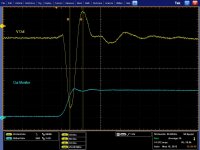 begemot_107_Vout_50ns_upstep_20mv.jpg86.2 KB · Views: 108
begemot_107_Vout_50ns_upstep_20mv.jpg86.2 KB · Views: 108
Stability measurments.
.
Looks good!
Can I ask you what equipment you used for this measurement?
Jan
http://www.audio-perfection.com/forum/showthread.php?tid=78
.
All fully description is here, but in russian.
You may translate any translaters if you want.
.
.
All fully description is here, but in russian.
You may translate any translaters if you want.
.
???????????? ??????????? ???????? ??????? ? ??????? ??????????? ??????? ??????
.
All fully description is here, but in russian.
You may translate any translaters if you want.
.
Thanks. Can you give me the name of the equipment or software you used to make those Bode diagrams I asked about?
Ja
Would be nice to add current limiting to any regulator design. Then you can add OVP too 
If you need such a superior design, what is it powering, does it contain expensive components that need PS protection features?
Also suggest to add tracking, assuming that is something you want, that way you can save on one reference element and put the $ saved towards a tighter grade ref for higher accuracy.
If you need such a superior design, what is it powering, does it contain expensive components that need PS protection features?
Also suggest to add tracking, assuming that is something you want, that way you can save on one reference element and put the $ saved towards a tighter grade ref for higher accuracy.
Last edited:
Post 477 -- given that the power line frequency is 50Hz in Moscow, I am questioning those measurements which show the typical Audio Precision power line at 60Hz.
Post 478 -- the AP is quieter in the analog mode, but I don't know if the measurements you show are possible given the NE5532 error amplifier.
Post 480 -- output impedance is a not only a function of the pass transistor beta (you've shown a Darlington which is very high) but also the load. Is Zout -70dB relative to 50Ω or 1Ω?
I don't see any HP4194a type data although you state that it is one of the instruments used.
Post 478 -- the AP is quieter in the analog mode, but I don't know if the measurements you show are possible given the NE5532 error amplifier.
Post 480 -- output impedance is a not only a function of the pass transistor beta (you've shown a Darlington which is very high) but also the load. Is Zout -70dB relative to 50Ω or 1Ω?
I don't see any HP4194a type data although you state that it is one of the instruments used.
Thank you.
Dazzz, I don't think you should use the temp rise of a regulator as a measure for 'quality'.
The temp rise depends on how much watts it must absorb. This watts is the voltage from input to output times the output current. It is the same for any part only depends on the circuit they are used in.
Now a large package has more heat capacity so will heat up slower and not so much as a small package. And a heatsink will lower the temp rise of course.
But it is not the quality of the part.
Jan
The temp rise depends on how much watts it must absorb. This watts is the voltage from input to output times the output current. It is the same for any part only depends on the circuit they are used in.
Now a large package has more heat capacity so will heat up slower and not so much as a small package. And a heatsink will lower the temp rise of course.
But it is not the quality of the part.
Jan
Dazzz, I don't think you should use the temp rise of a regulator as a measure for 'quality'.
The temp rise depends on how much watts it must absorb. This watts is the voltage from input to output times the output current. It is the same for any part only depends on the circuit they are used in.
Now a large package has more heat capacity so will heat up slower and not so much as a small package. And a heatsink will lower the temp rise of course.
But it is not the quality of the part.
Jan
The temperature was just an example
built the same Voltage reg
For example
3.3V
Gives power to all audio processors
And it has a lot of
load
Over the 1A
With LT3081 hardly heats up
With LT1764 heats up much
With the same heatsink
In the same place circuit
The
LT3088 (800ma)
LT3081 (1.5A)
LT3091 (1.5A)
Amazing very stable voltage does not change even if the load light or very large.
also the lt3081 lt3091
has Programmable Current Limit
and
Positive or Negative Output Current Monitor
( Add CADJ 0.1Uf and diode and you have soft start . As the cap greater in value
the Soft start time is bigger and the Output Noise, PSRR,
Transient Response is Improving Especially in the lower frequencies )
Last edited:
As far as the title of this thread is concerned, no integrated regulator
can hold the candle to the LT3042.
< https://www.flickr.com/photos/137684711@N07/24070698809/in/album-72157662535945536/ >
Yes, I'd like to hear of others, especially a negative one.
Below 50 Hz, performance may be limited by the preamp.
regards, Gerhard.
can hold the candle to the LT3042.
< https://www.flickr.com/photos/137684711@N07/24070698809/in/album-72157662535945536/ >
Yes, I'd like to hear of others, especially a negative one.
Below 50 Hz, performance may be limited by the preamp.
regards, Gerhard.
Last edited:
As far as the title of this thread is concerned, no integrated regulator
can hold the candle to the LT3042.
< https://www.flickr.com/photos/137684711@N07/24070698809/in/album-72157662535945536/ >
Yes, I'd like to hear of others, especially a negative one.
regards, Gerhard.
I have a lot LT3042
Still not built with them Voltage Regulators
Only designed In LTSPICE
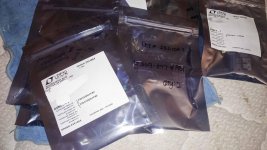
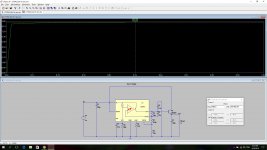
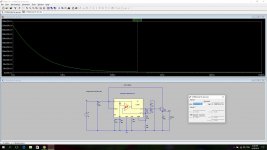
The temperature was just an example
built the same Voltage reg
For example
3.3V
Gives power to all audio processors
And it has a lot of
load
Over the 1A
With LT3081 hardly heats up
With LT1764 heats up much
With the same heatsink
In the same place circuit
What I wanted to explain is that if they are in the same circuit, they will dissipate exactly the same power.
If they have different temperature, it is because you use different packages, or a different PCB layout.
The temp does say noting about the regulator quality.
Edit: depending on the output load capacitance, a regulator can oscillate. In that case they can disipate more power and really heat up. Maybe that happens with some regulators.
Jan
Last edited:
This is funny. Especially the terms "Our" and "Russian answer".Our circuit works better...
This is my circuit and measurements. They were described in my thread of this forum ???????????? ??????????? ???????? ??????? ? ??????? ??????????? ??????? ??????
as soon as a couple of my Russian-speaking friends showed interest in it. More detailed description, measurement setup and calibration is described in this article https://linearaudio.net/article-detail/2257
This circuit has nothing to do with Russia as well as it was not designed to compete with Jung's or any other circuit. I fact, Walter Jung's publications inspired me to try it.This is Russian answer...
You absolutely right. Measurements were taken in US, in sunny Colorado. And yes, it is 60Hs.Post 477 -- given that the power line frequency is 50Hz in Moscow, I am questioning those measurements which show the typical Audio Precision power line at 60Hz.
As per network analyzer question, I tried both HP 4194A and AP instr 300 analyzers as soon as I had acsess to both. They showed similar results, but AP data is more convenient to save.
This is Russian answer to Salas's The simplistic Salas low voltage shunt regulator .
You absolutely right. Measurements were taken in US, in sunny Colorado. And yes, it is 60Hs.
As per network analyzer question, I tried both HP 4194A and AP instr 300 analyzers as soon as I had acsess to both. They showed similar results, but AP data is more convenient to save.
I still don't see how the noise shown in the chart is possible with an NE5532 error amplifier.
Will just have to build your reg and check for myself.
With regard to output impedance the Jung-Didden regulator gets below 10 microOhms.
As long as you have an AP at your disposal, try this -- put a signal on the supply rail through a good quality polypropylene cap, minimally load the supply to the point where it is consistently stable, run an FFT and look at the harmonics.
As far as the title of this thread is concerned, no integrated regulator
can hold the candle to the LT3042.
One impressive (little - MSSOP) device, missing from the datasheet -- output impedance.
I hadn't seen this application note previously -- picks up on an apnote which Jim Williams wrote some years previously: http://cds.linear.com/docs/en/application-note/an159fa.pdf
Another reason to purchase a tin of Danish butter cookies!
This is Russian answer to Salas's The simplistic Salas low voltage shunt regulator .Eugene this is really fanny, especially
Why are you mocking?!
There is a Moscow town in Kansas, and it is very close to Colorado
- Status
- This old topic is closed. If you want to reopen this topic, contact a moderator using the "Report Post" button.
- Home
- Amplifiers
- Power Supplies
- Best low noise regulator?
